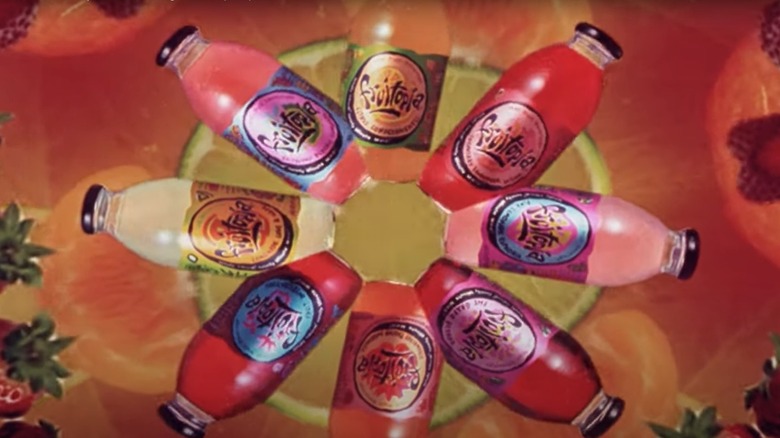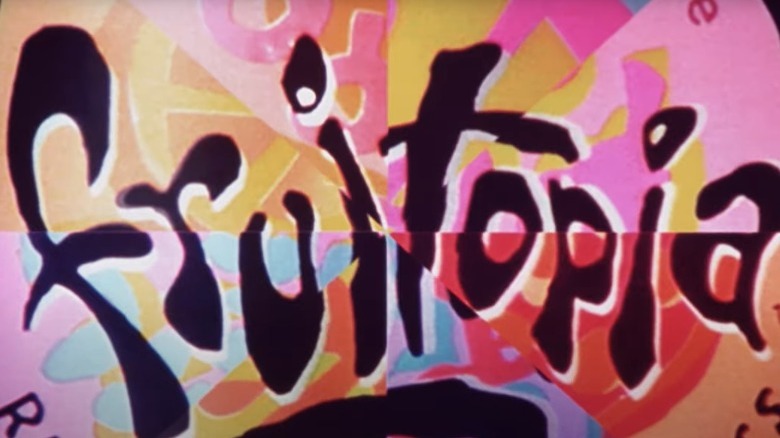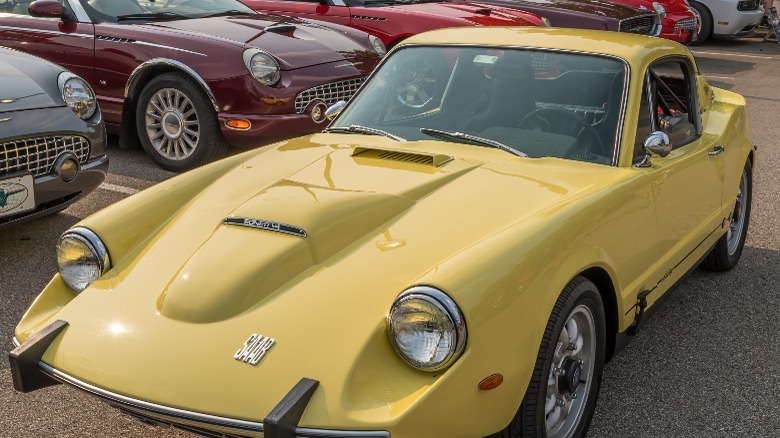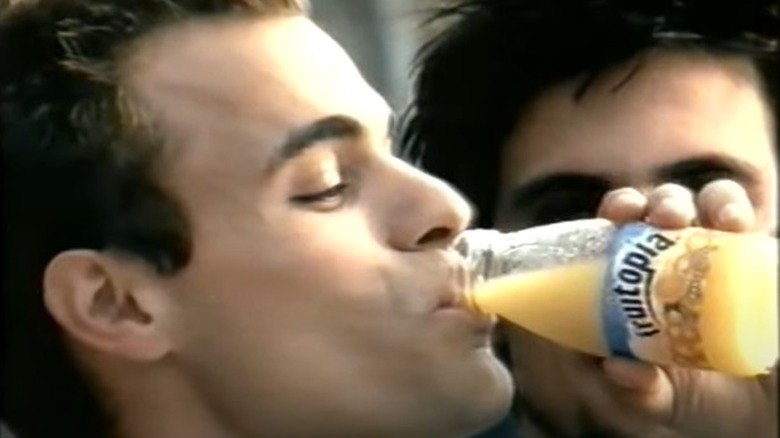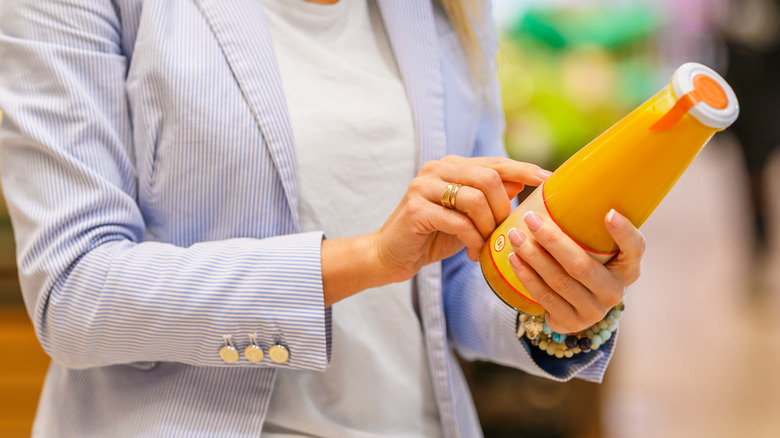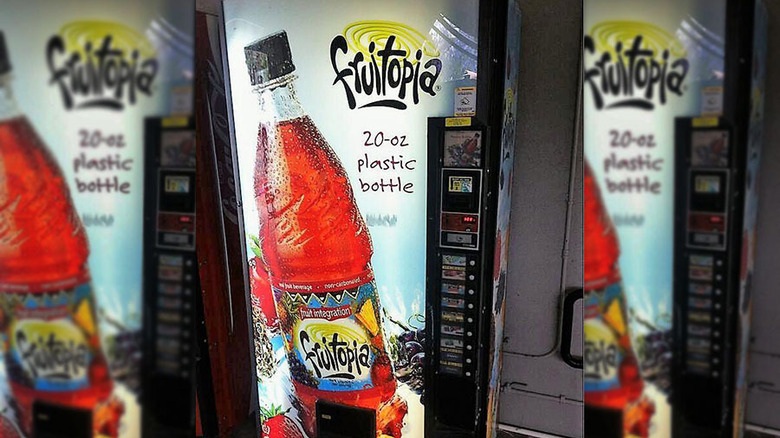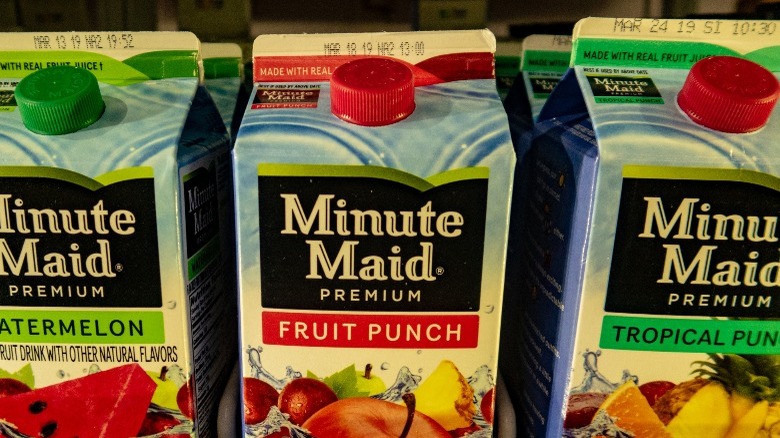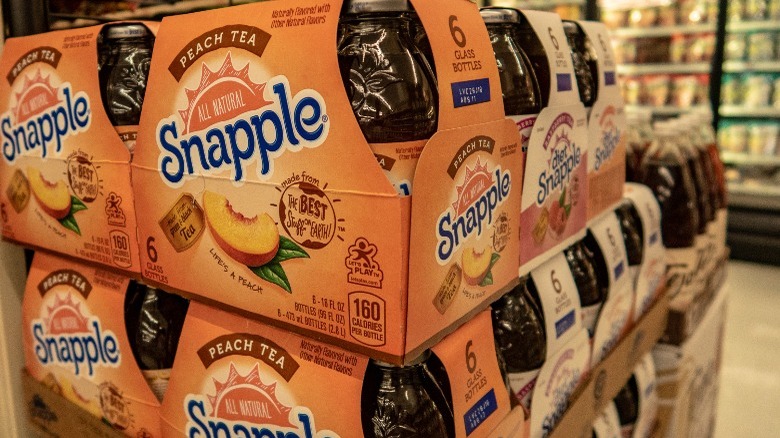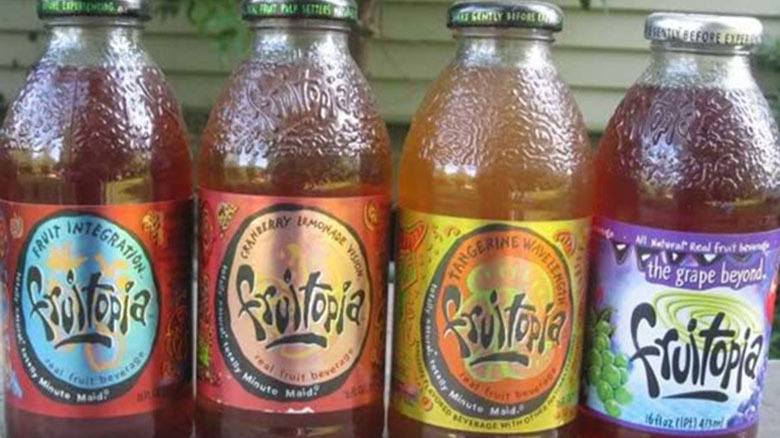Why Fruitopia Was Discontinued
When Fruitopia was introduced in 1994, Coca-Cola shook up its marketing tactics to please a crowd of baby boomers and Generation Xers who were moving away from the fizz of Coke. The carbonated beverage industry was coming undone, and alternative drinks were booming in the early '90s (via The New York Times). Coca-Cola launched Fruitopia to milk the trend.
Consumers were exposed to flavors named Citrus Consciousness and Strawberry Passion Awareness through ads that had kaleidoscopic images of fruits moving to the rhythm of trippy new-age music. But despite the $30 million effort to establish Fruitopia in the first year, per The New York Times, the beverage didn't seemed to perform well. When the scenario didn't improve in the following years, Coca-Cola decided that Fruitopia wasn't worth fighting for.
Though phased out from U.S. markets in 2003, as per Atlas Obscura, Fruitopia is still available up north in Canada. But the question is whether you would cross the border to take a sip of Fruitopia that failed for multiple reasons — the most simple being, as Tom Pirko, president of category consulting firm Bevmark, told Supermarket News in 2003: "it wasn't that exciting." Here are some of the other reasons Fruitopia was discontinued.
It wasn't selling well
A year after Fruitopia's launch, Coca-Cola embarrassingly trailed behind Snapple and Perrier, which were killing it in the alternative beverages game (per Beverage Digest via The New York Times). While the drink was predicted to bring in $400 million in sales for the company, the reality was a grim $60 million (per Beverage Marketing via Orlando Sentinel). And the following year, Coca-Cola realized that many of its Fruitopia flavors, including the Lemonade Love & Hope, were not getting much love and didn't have much hope in being a hit among consumers (via The New York Times).
The brand dropped the lemonade version and five other flavors — Lemon Berry Intuition Tea, Cranberry Lemonade Vision, Curious Mango Tea, Tropical Consideration, and Apple Raspberry Embrace — because, in contrast to the name of that last flavor, few embraced the drinks or intuitively reached out for one of those bottles. Instead, Coca-Cola introduced two new flavors with similarly intriguing names — Mind Over Mango and Banana Vanilla Inclination.
Did that help? Not enough to have Coca-Cola live its utopian dream of ranking at the top in the alternative beverages market.
There was a clash of taglines with a car company
Since Fruitopia was launched at a time when consumers were ditching their carbonated staples for something that was healthier and non-carbonated, the brand thought it would be all-too-apropos to promote itself as good "for the mind, body and the planet" (via Orlando Sentinel). But just because people were warming up to healthier drinks didn't mean they forgot to have fun, Fruitopia. Customers naturally thought Fruitopia was taking itself a tad too seriously (via The New York Times).
To show that the brand was taking a chill pill, the company came up with new slogans. And one among them landed it in the soup with Saab — yep, the Swedish car company that asked people to "find your own road." According to The New York Times in 1996, the Leo Burnett Company, which is known for its popular Marlboro Man and Tony the Tiger ads, created a slogan for Fruitopia, which unfortunately looked like a regurgitated Saab ad. No one, even if they tried, could overlook the stark similarities between "find your own Fruitopia" and Saab's "find your own road."
Saab Cars USA Inc. filed a complaint against Coca-Cola, which probably pushed the company to abandon the slogan altogether. Instead, it came up with a more philosophical "Fruits Unite. Refreshment happens" saying and ultimately settled on a simple and direct "Fruitopia: We just want to make you feel good" (via The New York Times).
The ads didn't seem to work in its favor
Fruitopia made a major pivot in the way it was advertising itself. Some of its earlier ads had consumers pondering questions such as "Can a waiter be a tea?" and "Can a tea be a fruit?" But by the late '90s, the company probably realized that it needed to make ads more relatable to people.
As Frank P. Bifulco Jr., vice president for marketing at the Coca-Cola USA division of Coca-Cola in Atlanta, told The New York Times in 1997, ”Our advertising for Fruitopia wasn't working as hard as it needed to work.” Instead of portraying Fruitopia as a "fruit drink with a perspective, a socially conscious brand," Bifulco Jr. said the company needed to take it easy and just make Fruitopia look like a beverage that made people feel good. The new ads showed people engaged in athletic activities like biking down snowy hills and racing chariots — all while seeming to feel good doing it.
Coca-Cola decided to pump in a lot more money into ads for Fruitopia drinks — from $10.2 million in 1995 to anywhere between $15 million to $20 million in 1997, per The New York Times. And as if that wasn't enough, Coca-Cola also launched a national promotion that offered a chance for customers to win trips to Hawaii and New York or a coupon for a free pack of Wrigley's Juicy Fruit gum with every bottle.
There was too much competition
When Fruitopia came into the market, everyone already was used to quenching their thirst with Snapple's ready-to-drink iced tea, Clearly Canadian's flavored sparkling water, and Mistic fruit juices (via The New York Times). Clearly, there was a demand for "new age" drinks, and Coca-Cola wanted to put its best step forward in the industry. In 1993 alone, the category grew by 25%, per The New York Times, in comparison to a measly 2% to 3% growth in soft drinks.
Coca-Cola, with its Nestea ready-to-drink teas, Minute Maid juices and Nordic Mist sparkling water, had 8% of this market, and it wanted to up to a 30% market share in three years, as Sergio Zyman, Coca-Cola's then senior vice president and chief marketing officer, told The New York Times in 1994.
As a solution, it introduced Fruitopia — to compete with the other brands. "There's no question Fruitopia is very much of a me-too," Emanuel Goldman, a beverage industry analyst, told The New York Times. But as Tom Pirko, president of Bevmark, a category consulting firm based in California, told Supermarket News in 2003, Coke executives had a hunch that Fruitopia wouldn't stand a chance against Snapple. And it just so turned out they were right; Fruitopia couldn't sustain. In fact, as Pirko said, it shouldn't have been launched at all and was an "unnecessary product" (via Supermarket News).
It was criticized for being advertised to children
If you thought keeping kids away from sugar was a task today, hear this: Back in the '90s, Fruitopia vending machines were a thing in schools. A Reddit post titled "Prior to schools removing all the good stuff, we had Fruitopia machines" got a ton of responses, with many reminiscing the days when they could get a bottle of the sugary drink on campus. "Yup, that was my go-to drink every day for lunch," said a Reddit user with the moniker Salty_box. "It probably cost 50 cents or something ridiculous like that."
It wasn't just the vending machines. According to a 2000 report in The New York Times, Coke offered $1.5 million to the school board in Madison, Wisconsin, in exchange for allowing the brand to give students a specially designed nutrition curriculum that included Fruitopia — which, by the way, was only 10% to 25% fruit juice, per Orlando Sentinel — as part of the syllabus along with an exclusive vending contract and other promotional opportunities.
The Madison School Board, thankfully, said no to the curriculum, among other ideas that Coke floated — like Coke T-shirts, Instant Coke awards, and software with a Coke logo that helped students browse for college scholarships. But the board did allow some advertising in exchange for a certain amount of money to buy band uniforms, organize extracurricular activities, and fund other items, which angered parents who sent letters criticizing the board for promoting junk food to kids.
Coke chose Minute Maid over Fruitopia
Coke acquired Minute Maid in 1960, giving its customers the option to buy frozen concentrate orange juice cans and powdered orange juice, among other flavors. Three decades later, the brand's decision to add a new line of juice drinks — Fruitopia — within a company that already had a brand for juices — Minute Maid — failed. Fruitopia folded in less than 10 years, and some of its flavors were shifted into Minute Maid's line-up, per Supermarket News.
Though it's clear by now that there were many reasons for Fruitopia being a flop, a surprising one is that it was competing for attention within its own parent company. Ray Crockett, a spokesman for Coke in 2003, told Supermarket News, "We believe the Minute Maid brand has more staying power." Fair enough. Minute Maid had stood the test of time since 1945 when it was introduced as a possible option to keep soldiers hydrated during World War II (via Minute Maid) and was eager to expand beyond orange juice that it was most known for at the time.
Soon after Fruitopia was history, Coke juiced up the Minute Maid line with flavors such as Strawberry Passion, Tropical Citrus, Berry Kiwi, Raspberry Lemonade, and a limeade drink called Limonada.
It was considered a Snapple knockoff
While it's no secret that Coke introduced Fruitopia to be in direct competition with Snapple (via The New York Times), what many who spent the '90s sipping both brands wouldn't have missed is how uncannily similar they were. As noted in The New York Times, they both had wide-mouthed bottles, quirky flavors and an 89-cent retail price. A beverage industry analyst told The New York Times then what many probably thought but never said out loud: "It's basically a Snapple knock-off."
It wasn't the first time that Coca-Cola had introduced ideas that didn't seem like they were all-too-original. As per The New York Times, the brand's aluminum cans and diet cola that came out in the '60s were copied from Royal Crown Cola Company. And later, in the '90s, its ready-to-drink teas were just like what Snapple had already offered the world.
Unfortunately, Royal Crown Cola Company didn't survive the heat of competition brought by Coca-Cola's look-alike products; Snapple, on the other hand, thrived.
In fact, Leonard Marsh, chief executive and a founder of Snapple, told The New York Times that by introducing their own versions of teas, Coke and Pepsi had "legitimized" the tea business and helped Snapple — and him — flourish. Coke's launching of the Snapple-look-alike Fruitopia was just a round two of the same.
The name Fruitopia was already taken in Greece
Fruitopia couldn't have had world dominance in the fruit juice industry even if it had rolled out the tastiest of flavors. For, in one case, it wasn't what was inside the bottle but what was outside of it that limited which markets it could reach.
Turns out Fruitopia was not as uniquely sounding a name as Coca-Cola probably thought it was. When the company took its juice line to the shores of Greece and tried to trademark the name, a popular Greek children's book author, Eugene Trivizas, faced off the beverage behemoth in court, per The Independent. Trivizas, who had penned over 100 books and earned quite a name in Greece by that time, couldn't allow someone else, even if it was a goliath of a company, to put a trademark on Fruitopia — the imaginary place where his popular stories were set.
Finally, it came down to whether the author's characters such as Bitter Lemon and Sweet Pea that Greek kids had read and loved would win the battle against a beverage that was trying hard to build a fan base. Ultimately in 2003, the court ruled in Trivizas' favor, and Coke had to withdraw its trademark request.
And since then, for the Greek, Fruitopia remains not a drink, but the land where Grapes of Wrath and Spill the Bean have their adventures.
Fruitopia's parent company ran into some legal issues
Coke, in its pursuit to be No. 1 in the beverage industry, decided to pay convenience stores and supermarkets in exchange for promotion of its drinks, including Fruitopia, in stores (via The New York Times). Sounds harmless? Only it wasn't. Coke just didn't want a sizable amount of advertisement, but in many cases, it made sure that it was the only beverage that the convenience store advertised. The aggressive marketing, naturally, hurt many of the other smaller beverage companies that possibly did not have as much dough as Coke to shell out on marketing.
But the desire to have it all landed Coke in a murky legal battle when a bunch of Royal Crown Cola dealers sued the brand in 1994 for using unfair practices — like paying off convenience stores for exclusive ads that left little opportunity for other brands to grow. In 2000, Coca-Cola was ordered to pay $15.6 million after a jury found that Coke broke Texas antitrust laws when it demanded exclusive "advertising, displays and vending machines" in stores.
